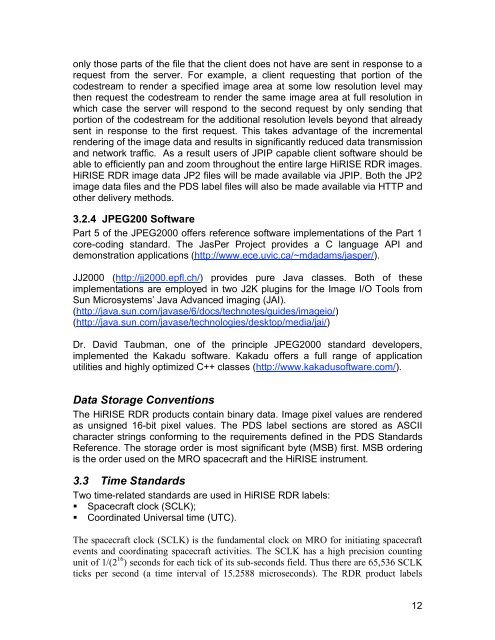Software Interface Specification for HiRISE Reduced Data Record ...
Software Interface Specification for HiRISE Reduced Data Record ...
Software Interface Specification for HiRISE Reduced Data Record ...
You also want an ePaper? Increase the reach of your titles
YUMPU automatically turns print PDFs into web optimized ePapers that Google loves.
only those parts of the file that the client does not have are sent in response to a<br />
request from the server. For example, a client requesting that portion of the<br />
codestream to render a specified image area at some low resolution level may<br />
then request the codestream to render the same image area at full resolution in<br />
which case the server will respond to the second request by only sending that<br />
portion of the codestream <strong>for</strong> the additional resolution levels beyond that already<br />
sent in response to the first request. This takes advantage of the incremental<br />
rendering of the image data and results in significantly reduced data transmission<br />
and network traffic. As a result users of JPIP capable client software should be<br />
able to efficiently pan and zoom throughout the entire large <strong>HiRISE</strong> RDR images.<br />
<strong>HiRISE</strong> RDR image data JP2 files will be made available via JPIP. Both the JP2<br />
image data files and the PDS label files will also be made available via HTTP and<br />
other delivery methods.<br />
3.2.4 JPEG200 <strong>Software</strong><br />
Part 5 of the JPEG2000 offers reference software implementations of the Part 1<br />
core-coding standard. The JasPer Project provides a C language API and<br />
demonstration applications (http://www.ece.uvic.ca/~mdadams/jasper/).<br />
JJ2000 (http://jj2000.epfl.ch/) provides pure Java classes. Both of these<br />
implementations are employed in two J2K plugins <strong>for</strong> the Image I/O Tools from<br />
Sun Microsystems’ Java Advanced imaging (JAI).<br />
(http://java.sun.com/javase/6/docs/technotes/guides/imageio/)<br />
(http://java.sun.com/javase/technologies/desktop/media/jai/)<br />
Dr. David Taubman, one of the principle JPEG2000 standard developers,<br />
implemented the Kakadu software. Kakadu offers a full range of application<br />
utilities and highly optimized C++ classes (http://www.kakadusoftware.com/).<br />
<strong>Data</strong> Storage Conventions<br />
The <strong>HiRISE</strong> RDR products contain binary data. Image pixel values are rendered<br />
as unsigned 16-bit pixel values. The PDS label sections are stored as ASCII<br />
character strings con<strong>for</strong>ming to the requirements defined in the PDS Standards<br />
Reference. The storage order is most significant byte (MSB) first. MSB ordering<br />
is the order used on the MRO spacecraft and the <strong>HiRISE</strong> instrument.<br />
3.3 Time Standards<br />
Two time-related standards are used in <strong>HiRISE</strong> RDR labels:<br />
Spacecraft clock (SCLK);<br />
Coordinated Universal time (UTC).<br />
The spacecraft clock (SCLK) is the fundamental clock on MRO <strong>for</strong> initiating spacecraft<br />
events and coordinating spacecraft activities. The SCLK has a high precision counting<br />
unit of 1/(2 16 ) seconds <strong>for</strong> each tick of its sub-seconds field. Thus there are 65,536 SCLK<br />
ticks per second (a time interval of 15.2588 microseconds). The RDR product labels<br />
12




